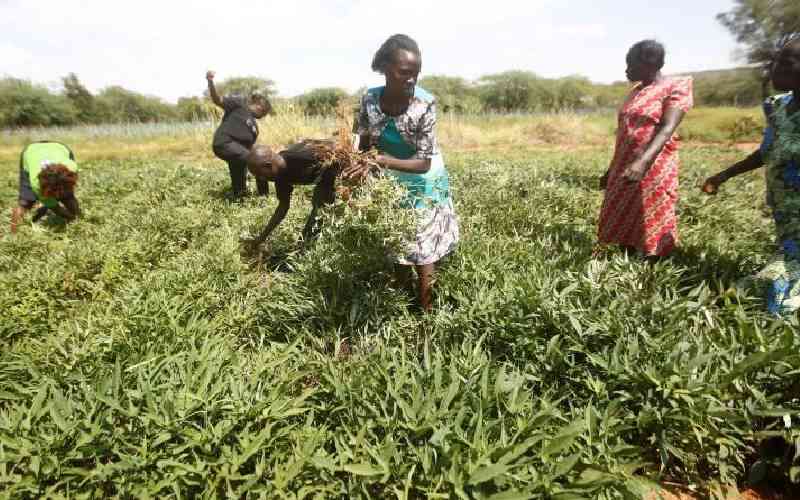
In its updated 2020 climate action plan to reduce greenhouse gases and adjust to the impacts of current or expected climate change, Kenya pledged to establish domestic legislation and an institutional framework to govern participation in both carbon market and non-market mechanisms.
As a result, President William Ruto signed the Climate Change Bill 2023 just days before the inaugural African Climate Summit in September 2023. This bill integrated carbon markets into the Climate Change Act of 2016, creating a framework for Kenya to engage in the global carbon markets.
Kenya had received $491 million for climate mitigation and just $21.3 million for adaptation, despite the latter being identified with the highest potential return on investment. The allocation of climate finance has been disproportionately skewed towards mitigation, with 55% of the total funds directed there and only 45 per cent allocated to adaptation.
Compounding this issue, nearly 79 per cent of the international public climate finance was provided as loans, further exacerbating Kenya's already challenging debt situation. This financial strain has been intensified by climate-related disasters, such as the 2022–2023 prolonged drought and deadly floods early this year, which have created an economic liability equivalent to 2–2.8 percent of Kenya's annual gross domestic product (GDP).
Moreover, Kenya faces significant climate challenges, with a vulnerability index of 0.53 and a readiness index of 0.3—where higher values indicate greater vulnerabilities or higher readiness. Given these challenges, there is an urgent need to mobilize more climate finance through grants and other innovative mechanisms, with the government advocating for carbon credits as a promising solution that could alleviate the debt burden while effectively supporting adaptation and mitigation efforts.
With 17 new clauses, the Climate Change Act paved the way for regulating carbon markets for both public and private entities in Kenya. Anne Njoroge, an advocate of the High Court and Program Officer at Natural Justice notes that this is a positive step because a lack of proper policies to regulate the clean development mechanism under which the carbon markets fall has been a drawback, making it difficult to protect human and environmental rights.
Kenya has the potential to reduce or avoid 30 metric tonnes of carbon dioxide equivalent per year. Implementing projects that achieve this reduction could generate up to $600 million annually from regulatory compliance and the voluntary carbon market by 2030. Between 2016 and 2021, Kenya issued the most carbon credits at 26 metric tonnes, which was more than any other African country and approximately 20 percent of total African credits. Interest in carbon markets is likely to grow with the President referring to carbon credits as the next significant export during the 27th Conference of Parties to the United Nations Framework Convention on Climate Change (COP27) held in Egypt in 2022.
- Misdiagnosis, climate change to blame for pathogens' resistance to drugs
- Scorching truth: How climate change aggravates brain diseases
- Africa pushes for climate justice at COP 29, seeks $1.3tr financing promise
- Setback as Africa calls for trillions for mitigation efforts
Keep Reading
The concept of carbon credits can be traced back to the Kyoto Protocol in 1997, an international agreement that laid the groundwork for countries to collectively address climate change by setting a limit on the greenhouse emissions for developed countries and allowing them to trade their allowances or offset the excess through selling and buying of carbon credits. The protocol implemented three key market mechanisms: Emission trading mechanisms that set a regulatory cap on emissions in specific sectors, the clean development mechanism that enables developed countries to invest in emissions reduction projects in developing countries, and the joint implementation mechanism, which allows one developed country to identify a project to reduce greenhouse gas emissions while another developed country provides financial and technological support for implementation.
Carbon credits and global warming
Developed countries are responsible for 79 percent of historical carbon emissions because the industrial revolution was fuelled by fossil fuels. This has greatly contributed to the warming of the planet (global warming). With the Paris Agreement target of 1.5 degrees Celsius, which is linked to reducing emissions by 45 percent by 2030, carbon credits have been proposed as a mitigation for climate change, with developed countries required to bear more responsibility in reducing emissions as they are still the key contributors. According to Mr. Charle Chalo, Kenya and other African countries have a lot of potential for carbon projects, especially in the forestry sector, which is technically referred to as the agriculture, forestry, and other land use sectors.
How does it work?
“It's a double-edged sword for Kenya and Global South countries because we contribute very little carbon emissions. While it is great that we will be incentivised to continue with the conservation efforts that will reduce emissions, we run the risk of slowing down our development efforts because we need industries to develop. Developed countries are investing in Africa to offset their emissions from their industries through carbon credits, yet we are the ones who are mitigating the sins of developed countries while continuing to be a consumer population and providing a market for their products,’ says Steve Itela, the team lead at Conservation Alliance of Kenya.
“We also do not have the expertise to measure how much credit we store in our soil, grass, and forests. We still rely on foreign experts to come and measure the amount of carbon that can be offset using the credits, and they calculate and turn it into carbon credits. So we are lagging in expertise,” he adds.
Forced climate financing tool
Ms. Jessica Mwanzia, a climate finance expert and a climate finance thematic lead at the PanAfrican Climate Justice Alliance (PACJA), argues that carbon credits may not be the most effective solution for financing climate change efforts in Kenya and Africa. This perspective opens a critical discussion on the emerging issues surrounding carbon credits as a financing mechanism, exploring its benefits, challenges, and potential alternatives for sustainable climate action in the region.
“Carbon credits are not the best approach in Kenya and Africa because our priority should be adaptation to the impact of climate change, considering that Africa produces around three percent of the global greenhouse emissions and the Congo Forest Basin sequesters (the process of capturing and storing carbon emissions from the atmosphere) around four percent of the total global greenhouse emissions. This means that Africa's net emission is zero,” she says.
She terms carbon credits as a forced climate financing tool that needs restructuring.
She stresses that the way the global carbon markets are structured, it is difficult to see how a carbon credit initiative has contributed to the removal of greenhouse gases from the atmosphere.
“We need to be truly sure that these projects are contributing to actual reductions in emissions, and we are not just assuming them or overestimating them," she emphasises.
“Moreover, we must ensure that emission reductions are truly permanent and not just temporary or reversible. This requires long-term monitoring and safeguards against the reversal of carbon sequestration,” she continues.
“There's also the issue of double counting, which refers to a situation where the same emission reduction or removal is counted more than once towards achieving climate goals,” she explains.
For instance, a carbon credit generated in Kenya could be counted both by the country that purchases the credit and by Kenya itself toward their respective climate targets, such as Nationally Determined Contributions under the Paris Agreement. In another instance, a single carbon reduction project might issue credits to multiple buyers or be claimed by multiple entities within Kenya, effectively duplicating the environmental benefit. Lastly, credits might be issued by different authorities, like the national government and county government, for the same project, leading to the same reduction being counted in different inventories or reports, and this undermines the integrity of carbon markets and climate mitigation efforts by inflating the reported emissions reductions, which can hinder real progress in combating climate change.
Ms Mwanzia advises implementing robust accounting and registry systems to track carbon credits and prevent double counting, both within the country and across borders. She suggests that this could involve centralised registries and independent audits.
“One of the requirements for one to undertake a carbon market project is ownership of land. However, most of the projects will be conducted on community land; there are no title deeds for community land. With no provisions on how to address projects being undertaken on community land in the updated act, for instance like getting consent from the community, this creates a loophole for conflict,’’ explains Ms. Njoroge.
"Another important issue is that while the community will be involved in the implementation of carbon credit projects, they are not involved in the negotiation of benefits, which means they could easily be cheated out of their entitlements. Additionally, while community agreements stipulate that a certain share of the money goes to development projects and a schedule of these projects is created, the communities should be left to decide their priorities in terms of the projects.”
Ms. Njoroge further emphasises the importance of free, prior, and informed consent, as well as public participation for community members before the onset of a carbon credit project. Ms. Mwanzia cites the issues with the Northern Kenya Grassland Carbon Project, where the local community was not adequately informed about the project's impact on their land use and access. The lack of adequate communication led to conflicts and grievances within the community, causing the project to lose funding as the community withdrew their support. The project interfered with traditional land use, particularly grazing livestock, by limiting access to the areas where the project was implemented.
On the issue of division of revenues from carbon revenues, Ms. Mwanzia advocates for an increase in the percentage of revenue that goes directly to local communities hosting the projects for land-based projects or using innovations, for instance improved jiko or solar for non-land-based projects.
“The current 40 per cent for land-based projects and 25 per cent for non-land-based projects is too low and does not adequately compensate communities for their role,” she states.
Additionally, she cautions on the need for proper costing of these projects to ensure African countries are getting the right share. For instance, a carbon credit is valued at $6 at the local or national level but sells for $60 on the global market—a disparity she describes as enslavement.
“Climate impact and vulnerability assessments have to be undertaken besides the environment impact assessment, which is missing in the provisions in the updated Climate Change Act before one undertakes a carbon credit project. This is necessary because we are looking at reducing emissions; thus, the issue of climate change is at the centre of it, and the assessment will look into how the efforts of these projects are contributing to reducing emissions.
“In addition, the assessment should be subjected to meaningful public participation where communities are made to understand what the projects mean for them. They should be provided with adequate information to have the agency to decide for themselves. More importantly, there should be safeguards to hold foreign entities accountable for human rights abuses,’’ says Ms Njoroge.
“Carbon markets are not a viable solution to mobilise climate finance and build the resilience of communities across Africa at scale and with the urgency required. While they have the potential to contribute to global decarbonisation, there are significant concerns that need to be addressed,’’ she adds.
“Adequate and effective policies must be put in place and strictly enforced to protect the human and land rights of the local and Indigenous communities where carbon market projects are being implemented. Without these protections, there is a high risk of exploitation, forced displacement, and loss of livelihoods, which can exacerbate existing vulnerabilities and inequalities. A fair distribution of resources is vital to ensure that the benefits of carbon market projects are shared with the communities rather than being monopolised by project developers and governments. This requires transparent mechanisms and robust oversight to ensure accountability,” she advises.
She adds that carbon markets should not be used as a vehicle to exonerate the developed countries, which are mandated by Article 9 of the Paris Agreement to provide financial resources to developing countries for both climate adaptation and mitigation. The current carbon market system permits the developed countries to continue polluting unabated while paying as little as less than $2 per metric tonne of carbon offset to African countries. The emission reductions claimed by these projects are frequently exaggerated, and many false carbon credits are issued, failing to deliver the promised environmental benefits.
African leaders should focus on pushing for real and substantial greenhouse gas emission reductions by the major polluters rather than embracing the flawed carbon market system. Moreover, they should engage proactively with wealthy nations to demand adequate, predictable, timely, and grant-based finance for adaptation, mitigation, and loss and damage, while making sure the most vulnerable groups of the society benefit.
Ms. Mwanzia poses a critical question: "Given that Kenya's emissions constitute just 0.1 per cent of the global total emissions, how do carbon credits, aimed at mitigating these emissions, become a crucial source of climate financing for us?”
Ms. Mwanzia emphasises the obligation of developed countries that pollute the environment to compensate for the damage caused. She notes that this agreement binds them to provide climate financing for African countries and says that they must honour their commitments and deliver adequate and timely climate financing on a grant basis. Such support is crucial for communities in Kenya and other African countries to build their resilience against climate change.
This article was produced as part of the Aftershocks Data Fellowship (22-23) with support from the Africa Women’s Journalism Project (AWJP) in partnership with The ONE Campaign and the International Center for Journalists (ICFJ).
 The Standard Group Plc is a multi-media organization with investments in media platforms spanning newspaper print
operations, television, radio broadcasting, digital and online services. The Standard Group is recognized as a
leading multi-media house in Kenya with a key influence in matters of national and international interest.
The Standard Group Plc is a multi-media organization with investments in media platforms spanning newspaper print
operations, television, radio broadcasting, digital and online services. The Standard Group is recognized as a
leading multi-media house in Kenya with a key influence in matters of national and international interest.











